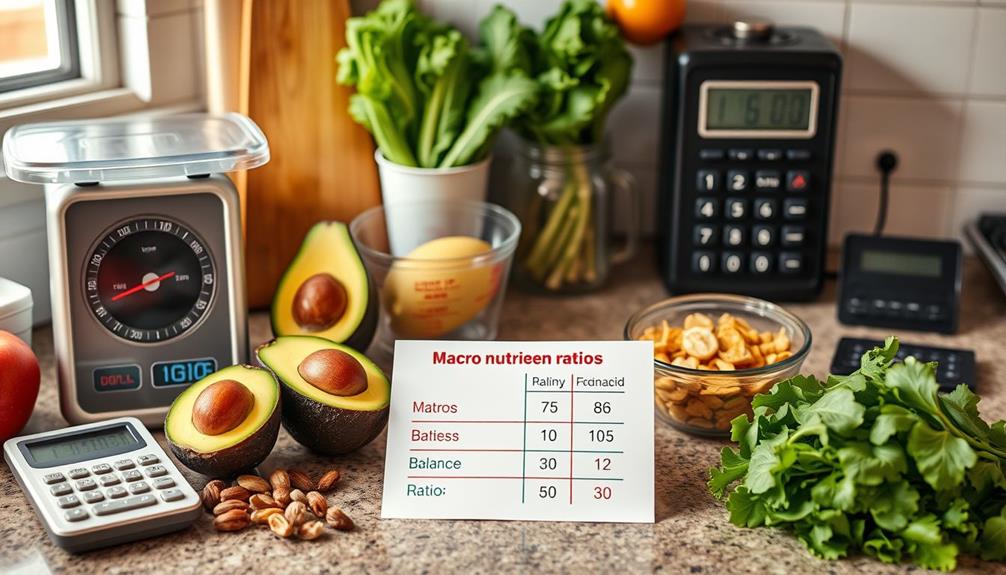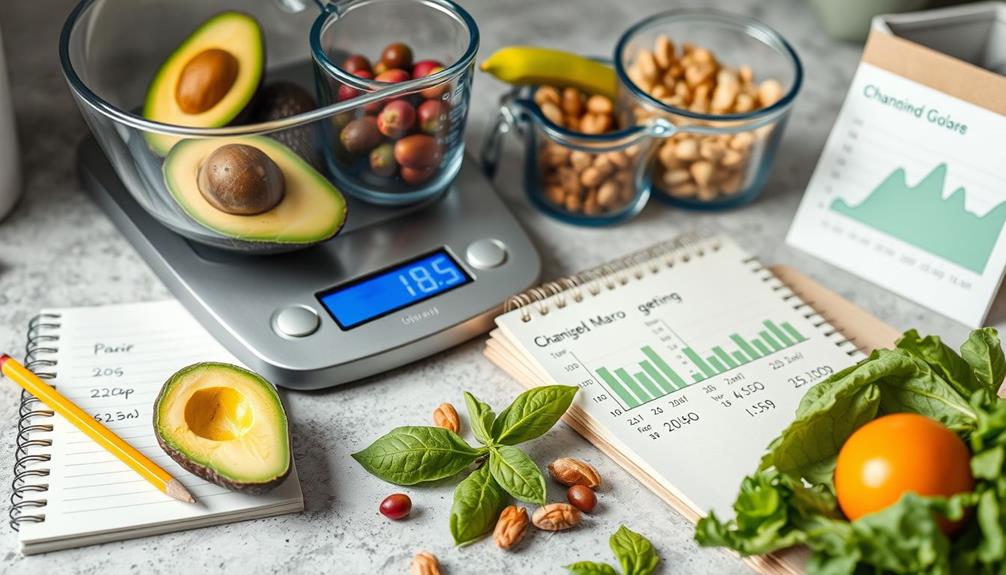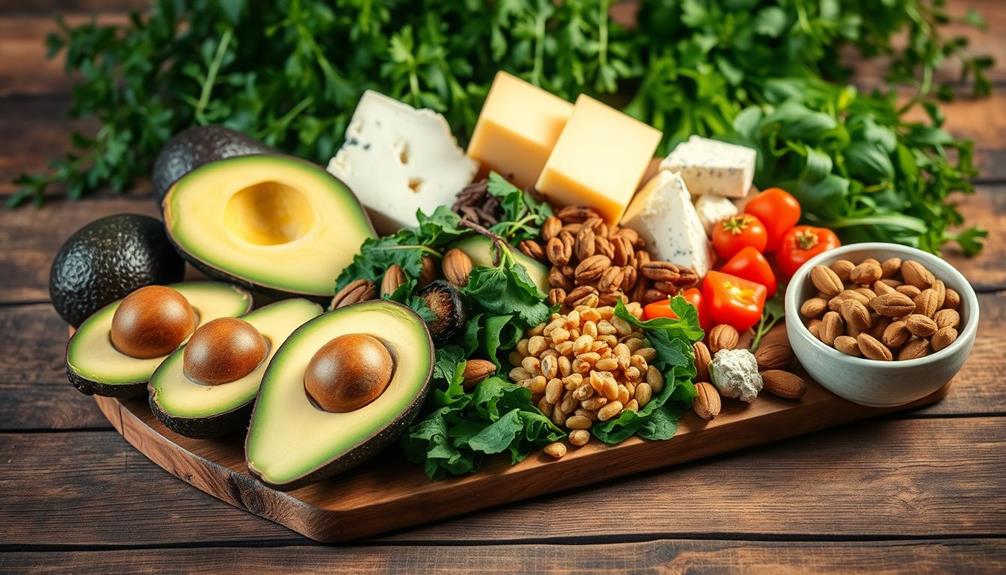To calculate your macros for a keto diet, start by determining your Total Daily Energy Expenditure (TDEE) using your Basal Metabolic Rate (BMR) and activity level. Typically, aim for a macro ratio of 70-80% fats, 15-25% protein, and 5-10% carbs. Keep your carb intake below 50 grams per day to maintain ketosis. It's crucial to log your food to track these ratios accurately. Adjust as needed based on your progress and how your body responds. There's plenty more helpful information that can guide you through this process effectively.
Key Takeaways
- Determine your Total Daily Energy Expenditure (TDEE) using your Basal Metabolic Rate (BMR) and activity level for accurate calorie needs.
- Aim for a typical keto macro ratio of 70-80% fats, 15-25% protein, and 5-10% carbs to maintain ketosis.
- Calculate net carbs by limiting intake to 20-50 grams daily to support ketosis effectively.
- Use a keto macro calculator to customize your macronutrient needs based on your goals and activity level.
- Regularly log food intake with tracking apps to monitor and adjust your macronutrient ratios as needed.
Understanding Macros and Keto

When you immerse yourself in the ketogenic diet, understanding macronutrients is fundamental. These macronutrients—carbohydrates, protein, and fats—play a significant role in how your body functions and utilizes energy. The ketogenic diet emphasizes a specific macro ratio, typically around 5% carbohydrates, 20-30% protein, and 70-80% fats. This ratio encourages your body to burn fat for fuel instead of glucose.
Additionally, maintaining a balanced intake of nutrients is essential to avoid deficiencies, similar to the considerations one must take when following a juice diet, which may lead to nutrient imbalances if not properly managed juice diet considerations.
On a keto diet, you'll limit your carbohydrate intake to about 20-50 grams of net carbs per day. This restriction helps induce and maintain ketosis, a state where your body primarily uses fat for energy.
Your protein needs will depend on your activity level, generally ranging from 0.6g to 1.2g per pound of lean body mass. This guarantees you maintain muscle without disrupting ketosis.
Fat intake will fill the remainder of your caloric intake, making it the primary source of energy. By understanding how to balance these macronutrients, you can optimize your energy expenditure and achieve your health goals on a ketogenic diet.
Calculating Your Daily Calories

To calculate your daily calories, start by determining your Basal Metabolic Rate (BMR) using the Mifflin-St. Jeor Formula.
Understanding your budgeting essentials can help you allocate resources for meal planning and food purchases.
After that, factor in your activity level to find your Total Daily Energy Expenditure (TDEE).
Determine Basal Metabolic Rate
Calculating your Basal Metabolic Rate (BMR) is essential for understanding how many calories your body needs at rest. Your BMR signifies the calories required for basic functions like breathing and circulation. To find your BMR, use the Mifflin-St Jeor equation based on your age, gender, height, and weight.
Here's a quick reference table for BMR calculations:
| Gender | Formula | Example (70 kg, 175 cm, 30 years) |
|---|---|---|
| Male | BMR = 10 * weight + 6.25 * height – 5 age + 5 | BMR = 1665 kcal |
| Female | BMR = 10 weight + 6.25 * height – 5 * age – 161 | BMR = 1485 kcal |
Once you calculate your BMR, you can find your Total Daily Energy Expenditure (TDEE) by multiplying your BMR by an activity factor that reflects your activity level. Understanding your BMR is vital for setting caloric intake goals, whether for weight loss or maintenance. This knowledge also aids in calculating appropriate macronutrient ratios on a keto diet, ensuring you meet your calorie needs effectively.
Factor in Activity Level
Understanding your activity level is vital for accurately estimating your daily calorie needs. Start by calculating your Basal Metabolic Rate (BMR) using the Mifflin-St. Jeor formula, which takes into account your age, gender, height, and weight.
Once you have your BMR, you can determine your Total Daily Energy Expenditure (TDEE) by multiplying your BMR by an activity factor. For instance, use 1.2 for sedentary, 1.375 for lightly active, 1.55 for moderately active, 1.725 for very active, and 1.9 for extra active lifestyles.
Additionally, it's important to take into account how various health factors can influence your metabolism, including conditions like gout nutrition, which may require dietary adjustments that affect caloric needs.
Knowing your TDEE is essential, as it reflects the calories you need to maintain your current weight. If you're aiming for weight loss, you'll need a caloric deficit, while a surplus is necessary for muscle gain.
Regularly reassess your activity level, as changes in your exercise routine can affect your energy needs.
To simplify this process, think about using a keto macro calculator. It can help you adjust your daily calorie intake based on your specific activity level and weight goals, ensuring you're on track with your protein intake, fat intake, and carbs per day for best results on your keto diet.
Set Caloric Goals
Setting your caloric goals for a ketogenic diet starts with determining your Total Daily Energy Expenditure (TDEE). You can calculate your TDEE by multiplying your Basal Metabolic Rate (BMR) by an activity factor, which ranges from 1.2 for sedentary lifestyles to 1.9 for very active individuals.
For ideal health, it's also important to guarantee that your diet includes a variety of nutrient-dense foods to support overall well-being, as highlighted in lifestyle for longevity. Once you have your TDEE, you can set caloric goals based on your weight loss or maintenance objectives.
For effective weight loss, aim for a caloric deficit of 20-30% below your TDEE. This will help you shed those extra pounds while ensuring your macronutrient ratios align with keto guidelines—typically 5% carbs, 20-30% protein, and 70-80% fat.
It's crucial to take into account your protein needs, as protein helps maintain muscle while your body uses fat for energy.
To maintain your weight, simply match your caloric intake to your TDEE. Remember to regularly reassess your caloric goals, adjusting your intake and macro ratios as your weight changes. This will keep you on track with your keto diet and help you achieve your desired results.
Determining Macronutrient Ratios

To get the most out of your keto diet, you need to understand the right macronutrient ratios for your goals. Typically, you'll aim for about 5% carbs, 20-30% protein, and 70-80% fat.
Exploring different recipes can help you achieve these ratios while enjoying the process of meal preparation, just as coffee enthusiasts embrace new brewing methods.
Adjust these ratios based on your activity level and specific weight loss objectives to stay on track.
Understanding Macro Ratios
When starting on a ketogenic diet, grasping the right macronutrient ratios is vital for achieving your health goals. The typical macronutrient distribution for keto consists of about 70-80% fat, 15-25% protein, and 5-10% carbs. This balance promotes ketosis by shifting your body's energy source from glucose to fat.
Incorporating essential oils, such as eucalyptus oil for respiratory health or peppermint oil for nausea relief, can further enhance your well-being during this dietary shift. For a 2,000 calorie ketogenic diet, this translates to roughly 25 grams of net carbs, 156-178 grams of fat, and 100-150 grams of protein.
To maintain ketosis, it's important to keep your carb intake below 50 grams per day. This helps sustain low blood sugar and insulin levels, which are necessary for effective fat burning. Your individual macronutrient needs may vary based on factors like activity level, age, and weight goals.
Using a keto macro calculator can simplify this process, allowing you to tailor your macronutrient ratios to your body weight and daily calorie needs. By understanding these macronutrient ratios, you can better manage your energy expenditure and align your diet with the principles of the ketogenic diet, ensuring you stay on track for success.
Adjusting Based on Goals
Adjusting your macronutrient ratios based on personal goals is vital to maximizing the benefits of the ketogenic diet. Start by determining your total daily caloric needs, which involves calculating your Basal Metabolic Rate (BMR) and factoring in your activity levels for Total Daily Energy Expenditure (TDEE).
Incorporating strategies for overall wellness, such as sleep better, can enhance your diet's effectiveness. The standard macronutrient ratio for keto is typically around 70-80% fats, 5-10% carbohydrates, and 15-30% protein. However, you can modify these percentages depending on your specific goals.
For weight loss, aim for a carbohydrate intake of about 20-50 grams of net carbs per day to promote ketosis and fat burning. Your protein needs will vary as well; sedentary individuals should target 0.6-0.8 grams per pound of lean body mass, while active folks may need 0.8-1.2 grams.
After calculating your carb and protein needs, fill the remaining calories with fats to meet your caloric goal. This approach guarantees a well-balanced macronutrient distribution, helping you achieve ideal keto results.
Activity Level Considerations

Your activity level plays an essential role in determining your macronutrient needs on a ketogenic diet. Understanding how your daily movements and exercise intensity affect your Basal Metabolic Rate (BMR) and Total Daily Energy Expenditure (TDEE) is vital.
This knowledge allows you to make more accurate macro calculations tailored to your energy requirements. Additionally, considering the importance of financial planning for care can help guarantee that your nutritional needs are met without financial stress, especially as you age or navigate health concerns.
Consider these activity levels:
- Sedentary: Little to no exercise; lower protein intake (0.6g-0.8g per pound of lean body mass).
- Lightly Active: 20 minutes of exercise daily; moderate adjustments to protein.
- Very Active: Intense physical job or daily intense exercise; higher protein intake (1.0g-1.2g per pound).
For active individuals, slightly increasing protein intake helps maintain energy levels while promoting ketosis.
Adjusting your macronutrient ratios based on your activity level guarantees you get enough energy for workouts while still achieving your keto goals. By recognizing your activity level, you can fine-tune your protein intake and overall macros, making your ketogenic journey more effective and enjoyable.
Setting Your Goals

Setting realistic goals is essential to your success on the keto diet. Start by evaluating your daily calorie needs using your Total Daily Energy Expenditure (TDEE). This helps you determine whether you're aiming to lose, gain, or maintain weight.
Additionally, diversifying your dietary choices, much like how diversification of retirement portfolio is important in investing, can enhance your keto experience. Next, focus on your carbohydrate intake; aim for 20-50 grams of net carbs per day to effectively achieve and maintain ketosis.
Calculate your protein needs based on your activity level. You should target 0.6-1.2 grams of protein per pound of lean body mass, which can vary depending on how active you are.
Once you have your carbs and protein figured out, establish your fat intake by using the remaining calorie allowance. This guarantees you meet your daily caloric goal while aligning with your body composition objectives.
Tracking Your Intake

Effective tracking of your intake is vital for maintaining your keto diet. By logging all the food you consume throughout the day, you can accurately monitor your macronutrient ratios and adhere to keto guidelines.
Utilizing best websites to earn money online can provide additional resources and tips for staying disciplined in your dietary goals. Here are some key strategies to help you stay on track:
- Use keto-friendly apps like Cronometer or MyFitnessPal for easy tracking.
- Calculate daily macro percentages by dividing calories from each macronutrient by your total daily caloric intake.
- Regularly review your food logs to identify discrepancies and adjust your intake as needed.
To guarantee you're meeting your goals, aim for typical keto ratios of 5% carbs, 20-30% protein, and 70-80% fat. It's essential to track net carbs by subtracting fiber from total carbohydrates. This way, you'll know how much protein you need and can monitor your caloric intake effectively.
Consistent tracking not only helps you maintain your keto diet but also provides insights into your eating habits and progress over time.
Adjusting Macros Over Time

Adjusting your macronutrient ratios over time is key to staying on track with your keto diet and achieving your weight loss goals. As you progress, regularly reassess your body composition and weight goals to ascertain you're maintaining an appropriate calorie deficit or surplus.
Tracking your progress weekly or biweekly helps identify any plateaus, allowing you to make necessary adjustments to your macros.
Remember that your Total Daily Energy Expenditure (TDEE) decreases as you lose weight, which means you'll need to adjust your macros to continue promoting fat loss effectively. If you ramp up your physical activity level, consider increasing your protein intake to support muscle maintenance and recovery, which will also influence your overall macro distribution.
It's essential to monitor your ketone levels and overall energy. If you experience decreased energy or trouble staying in ketosis, it might be time to reduce your protein intake slightly, as too much protein can hinder ketone production.
Resources for Success

To succeed on your keto journey, you'll often find it helpful to leverage various resources tailored to your needs. Here are some essential tools that can support your efforts:
- Keto Macro Calculator: Use this to determine your personalized macronutrient needs based on factors like age, gender, and activity level.
- Keto Food List: Access an extensive list to guide your food choices, focusing on allowed foods like meats, low-carb veggies, and healthy fats.
- Tracking Apps: Utilize tools like Cronometer or MyFitnessPal to track macros effectively, making it easier to log food intake and calculate net carbs automatically.
Additionally, consider using a 30-day meal planner like Keto Academy for structured guidance and recipes that align with your calculated macros.
Engaging with online communities or social media groups can also be invaluable for support, motivation, and recipe sharing.
These resources not only help you stay on track with your dietary goals but also make your keto journey more enjoyable and sustainable.
Embrace these tools to enhance your success and make informed choices on your keto path!
Frequently Asked Questions
How to Calculate Your Macros on Keto?
To calculate your macros, start by figuring out your daily caloric needs. Then, set your carb, protein, and fat targets based on your activity level and desired ratios to maintain a balanced nutritional intake.
What Is the Best Keto Macro Ratio?
The best keto macro ratio generally falls between 70-80% fats, 15-25% protein, and 5-10% carbohydrates. Adjust these percentages based on your personal goals, activity level, and how your body responds to the diet.
How Do You Calculate Net Carbs on Keto Diet?
To navigate the intricate waters of your meal plan, you'll subtract fiber from total carbohydrates and adjust for sugar alcohols. This way, you'll keep your net carbs in check and stay on track.
How Do I Find My Fat Macros on Keto?
To find your fat macros on keto, start by determining your total daily calories. Then, decide on your desired fat percentage, calculate the actual grams of fat, and track everything to stay on target.
Conclusion
To sum up, calculating macros for your keto diet isn't just about numbers; it's about balance, precision, and adaptation. You'll find your ideal calorie count, you'll determine your macronutrient ratios, and you'll track your progress. By adjusting your intake over time, you'll refine your approach and achieve your goals. Embrace the journey, stay committed, and remember that success comes from consistency, awareness, and a little bit of trial and error. You've got this!









